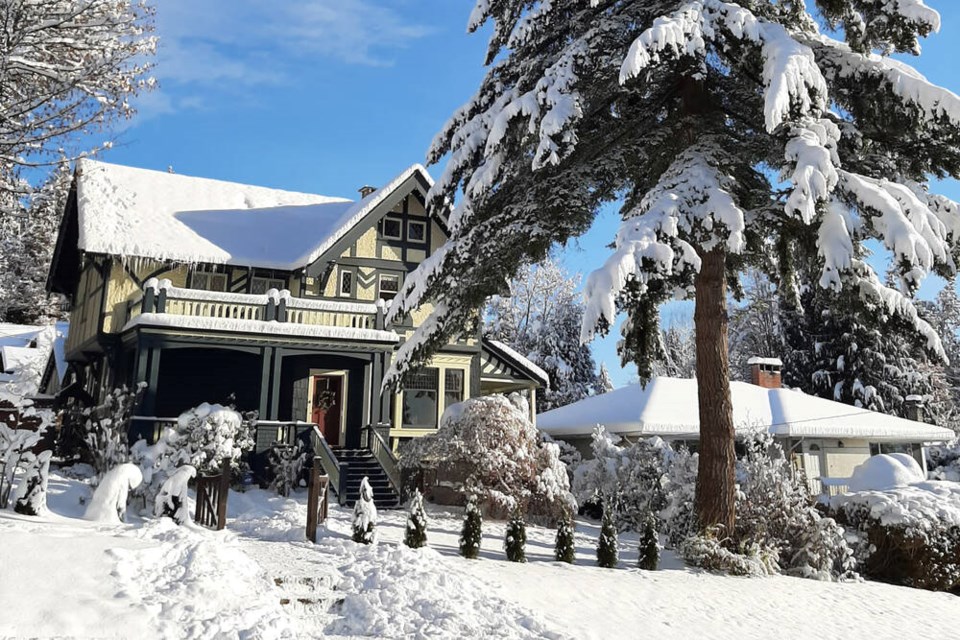On a plot overlooking Vancouver’s Burrard inlet sits something of a rarity.
With a gabled roof that sits above half-timbered, roughcast stucco walls, and stained-glass windows that refract light into rooms covered in their original wainscotting, the Cornish House, built in 1911, is an echo of the past and a testament to its builder and designer, Benjamin John Cornish.
An apprentice builder, Cornish arrived from England in the summer of 1887, a year after the great fire of Vancouver had ravaged the town. It was an opportunity to use his skills as the town rebuilt. In 1888, he and fellow emigrant Ernest Cooper founded building company Cornish & Cooper – initially working from a small workshop on Seymour Street, and later from more established premises on Dufferin Street (now Second Avenue). Their business specialized in sashes and doors.
Cornish’s lasting achievements include the magnificent spiral staircase in the Carnegie Library in Vancouver’s Downtown Eastside, which opened in 1903, and the auditorium of the First Church of Christ, Scientist (now Coastal Church) on West Georgia Street. History was less kind, however, to another of Benjamin’s builds. Designed by noted architect JJ Honeyman, the second courthouse in Fernie, B.C., opened in the spring of 1908 at a cost of $26,360. It was built with ornamental gables and roofing, elaborate front and rear entrances, and a magnificent west window, only for the building to perish in the fire of August that year.
Cornish’s influence on the Burrard Inlet’s northern shore was longer lasting. Soon after arriving in Vancouver, he had acquired – along with his friend, William Keene – a stake in land up the Capilano River. According to Cornish’s son, Charles, whose memoir is located in the North Vancouver archives, they would work all day Saturday and then row across the Inlet to the mouth of the Capilano River. From there, they walked up a trail to the homestead near the canyon. They worked on clearing the land and building a shack on Sundays, returning to Vancouver on Sunday nights.
In 1893, the two friends decided to seek land nearer to the inlet, making their own survey of the forest around what is now 15th Street and Lonsdale Avenue. An approach to the land’s owners, the North Vancouver Land and Improvement Company, was at first turned down. The company had neither surveyed the land nor decided to open it up to investors. However, as Keene reports in his journal, An Historical Review, dated 1941, a second approach by the two men later that year proved successful, with the NVLIC agreeing to sell them 20 acres on condition that they immediately started clearing the land, recruiting no less than four others to participate, who would build and reside on site.
To meet the requirement, Cornish and Keene brought in their friends, Alfred Crickmay (Keene’s brother-in-law), Arthur Diplock and Arnold Kealy. The first task was to clear the forest to build rudimentary cottages. A photograph in the archives dated 1897 shows Crickmay’s log cabin with three of the founding five (Cornish, Keene and Kealy) resting in front of it.
Building was no easy task, since timber had to be hauled by sleigh up the skid road from the Moodyville sawmill as far as Eighth Street, then carried in bundles up a track cut through the forest. Arthur Diplock’s son Thomas’s first recollections as described in his journal, The North Shore of Burrard Inlet from 1897 And Other Reminiscences, are less than favourable.
The earliest recollection I have of the North Shore, when I was about aged five, was the day we moved from our house in Vancouver’s west end in 1897. I can remember the walk or climb up the skid road (now Lonsdale Avenue) after landing from the tugboat “Senator” which was our one and only ferry…Our new home was little more than a shack, erected in a small cleared area in the middle of dense forest. It seemed to me that we were very far from civilization. The little “outhouse” was a poor substitute for a modern bathroom. The water supply from the wall was a bitter disappointment after being used to turning on a tap. All in all, it was not a very bright picture. We were at first, I think overwhelmed by the silence, the immensity of the enclosing forest and the mountains brooding behind.
A period followed when North Vancouver developed exponentially. A regular ferry service came into operation, together with a collection of businesses and stores at the wharf side. No longer a skid track for logging, Lonsdale Avenue became a dirt road, enhanced in 1906 by electrification. The running of the first trams negated the need to lug goods by hand or animal up the steep hill.
The grading of Lonsdale Avenue made plots to the north more accessible, such that in 1910 Cornish decided to sell up at 15th Street and acquire a one-acre plot further up the hill. Here, on the corner of Nye Road (now Windsor) and St. Georges Avenue, he designed and built the present-day Cornish House. It is down to a good slice of luck and the quality of Cornish’s build that the house stands today as a testament to this adventurous pioneer.
After buying Cornish House in the summer of 2022, Paul Haston said he became interested in researching North Shore pioneer Benjamin John Cornish.




